

Detalhes do Produto - Brandsclub - O mais completo clube de compras. As melhores marcas até 90% OFF. Trucker hat. Tam o' Shanter (cap) Taking the form of the brimless, bonnet cap that began to be worn throughout northwestern Europe during the 15th century, the Tam o' Shanter is usually made of wool and has a toorie (pom-pom) in the centre.

This distinguishes it from other folk bonnets such as the beret, for instance. Although brimless, the Tam o'Shanter has an external hatband which passes around the head's circumference, and this, too, distinguishes it from the beret: berets are either band-less where the beret meets the head, or have an internal hatband. Mini Caps Manufacturer - Uniform Mini Cap Exporter and Manufacturer. File:Sswoolm43.jpg. Shako. Sailor cap. The more rigid type of sailor hat with a wide, flat peak is also known as square rig (this refers generally to a type of sailor uniform) cap or pork pie (not to be confused with the brimmed pork pie hat).

The sailor cap was first introduced in 1811 as a part of the uniform in the Russian Navy (bezkozyrka, ru. бескозырка, non-peaked hat)[citation needed]. It was a development of the peaked cap in application to marine conditions. U.S. Navy and Bolivarian Armada of Venezuela sailors wear a unique white canvas hat with an upright brim, often referred to as a "Dixie cup" in reference to its similarity to the shape of a common disposable drinking cup,{cn} or a "gob hat" or cap. Phrygian cap. History[edit]
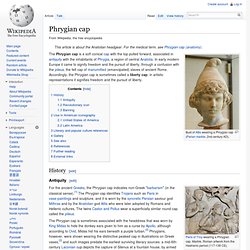
Nightcap (garment) "I have here delineated a night-cap, fixed in such a manner as to serve as one of the best bandages for the head.

" (1801)[full citation needed] A nightcap is a warm cloth cap worn while sleeping, often with pajamas or a nightshirt. They are similar to winter "beanies" worn in cold climates. They were common in northern Europe before central heating was available, when homes were cold at night. Women's night caps usually consisted of a long piece of cloth wrapped around the head. Men's nightcaps were traditionally pointed, with a long top, usually accompanied by a small ball of some sort, which was used similar to a scarf.
Through the 19th century nightcaps were often used by surgeons to secure bandages applied to wounds of the head. Newsboy cap. Eight-paneled caps in various colors.
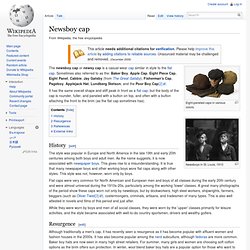
Newsboys in St. Detalhes do Produto - Brandsclub - O mais completo clube de compras. As melhores marcas até 90% OFF. Flat cap. History[edit] Woollen flat cap In the 19th and early 20th centuries, when men predominantly wore some form of headgear, flat caps were commonly worn throughout Britain and Ireland.
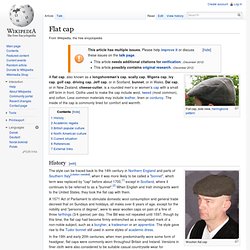
Versions in finer cloth were also considered to be suitable casual countryside wear for upper-class English men (hence the contemporary alternative name golf cap). Flat caps were worn by fashionable young men in the 1920s. Boys of all classes in the United Kingdom wore flat caps during this period. Balmoral bonnet. Design[edit] Originally with a voluminous crown, today the bonnet is smaller, made of finer cloth, and tends to be dark blue, black, or lovat green.

Ribbons in, or attached to the back of, the band (originally used to secure the bonnet tightly) are sometimes worn hanging from the back of the cap. A regimental or clan badge is worn on the left-hand side, affixed to a silk or grosgrain ribbon cockade (usually black, white or red), with the bonnet usually worn tilted to the right to display this emblem. The centre of the crown features a toorie, traditionally red. Some versions have a diced band (usually red and white check) around the circumference of the lower edge. History[edit] As worn by Scottish Highland regiments the "blue bonnet" Tam o' Shanter gradually developed into a stiffened felt cylinder, often decorated with an ostrich plume hackle sweeping over the crown from left to right (as well as flashes of bearskin or painted turkey hackles).
North American usage[edit] Other usage[edit] Ascot cap. The Ascot cap, also known as the Cuffley cap or Lippincott cap, is a hard men's cap similar to the flat cap, but distinguished by its hardness and rounded shape.

Ascot caps are typically made from felt or wool and worn in the fall or winter, but straw Ascots also exist for warmer weather. An Ascot being of a single color mostly matches up with casual clothes of that color or those who match it with a suit match up the color with the suit setup. Caubeen. A British army caubeen with a cap badge and green hackle Royal Irish Rangers uniforms The caubeen /kɔːˈbiːn/ is an Irish beret,[1] formerly worn by peasants.[2][3] It has been adopted as the head dress of Irish regiments of the British and Commonwealth armies.
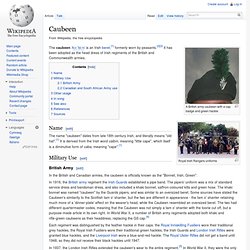
Name[edit] The name "caubeen" dates from late 18th century Irish, and literally means "old hat".[1] It is derived from the Irish word cáibín, meaning "little cape", which itself is a diminutive form of cába, meaning "cape".[1] Military Use[edit] Papakhi. Papakha (Armenian: փափախ; Azerbaijani: papaq; Georgian: ფაფახი [pʰapʰaxi]; Russian: папа́ха, IPA: [pɐˈpaxə]), also known as astrakhan hat in English, is a male wool hat worn throughout the Caucasus.
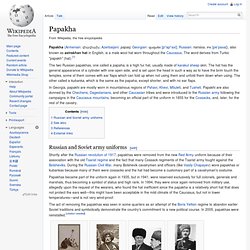
Ushanka. Ushankas provide warmth to the wearer in the winter. The word ushanka derives from ushi (у́ши), "ears" in Russian. Basic materials[edit] Military-style ushanka of the Soviet Army, as worn under baseball helmet. Made in Bobruysk, 1988. History[edit] Hats with flexible earflaps made out of fur have been known in Russia, Germany and Scandinavia for centuries. The standard modern-type ushanka with a perfectly round hat crown was developed and widely produced in 20th-century Russia. During the Russian Civil War, when Aleksandr Kolchak ruled in Siberia, he introduced around 1918 a winter uniform hat, commonly referred to as a kolchakovka, which was basically an ushanka with an extra eye-flap. During the Winter War, organizational failures and inadequate equipment left many Soviet troops vulnerable to cold, and many died of exposure. Late in the war, German soldiers started to wear ushankas, as well as other Soviet-type gear, as unofficial additions to their gear.[2]
Cap (sport) Sports cap awarded to a Perth Academy schoolboy in the UK in the 1930s. Glengarry. Soldiers of the former regiments of the Scottish Division (1968–2006) prior to amalgamation into the Royal Regiment of Scotland (2006) in Number 2. Pattern ceremonial dress History[edit] Traditionally, the Glengarry bonnet is said to have first appeared as the head dress of the Glengarry Fencibles when they were formed in 1794 by Alexander Ranaldson MacDonell of Glengarry, of Clan MacDonell of Glengarry. MacDonell, therefore, is sometimes said to have invented the glengarry but it is not clear whether early pictures of civilians or fencible infantry show a true glengarry, capable of being folded flat, or the standard military bonnet of the period merely 'cocked' into a more 'fore-and-aft' shape.[1] The first use of the classic, military glengarry may not have been until 1841, when it is said to have been introduced for the pipers of the 79th Foot by the commanding officer, Lieutenant Colonel Lauderdale Maule.[2] Modern wear[edit] Irish Army[edit]
Forage cap. Fez (hat) Cricket cap. John Lennon hat. John Lennon (front left), with Paul McCartney, holding a "John Lennon Hat" The Greek fisherman's cap is often associated with seamanship and marine situations. It has become popular amongst the public in general, rather than staying isolated as an occupational hat. One example of it being put in prominence of popular culture was when it was worn by John Lennon. Kippah. A kippah, kippa or kipa (/kɪˈpɑː/ ki-PAH; Hebrew: כִּפָּה or כִּיפָּה; plural: kippot כִּפוֹת or כִּיפּוֹת), also known as a yarmulke ( i/ˈjɑrməlkə/ YAR-məl-kə or /ˈjɑːməkə/ YAH-mə-kə from Yiddish: יאַרמולקע, from the Aramaic meaning "fear of the King" (i.e. God)), kapele (Yiddish: קאפעלע), is a hemispherical or platter-shaped cap, usually made of cloth, worn by Jews to fulfill the customary requirement held by some orthodox halachic authorities that the head be covered at all times.
It is usually worn by men and, less frequently, by women (in Conservative and Reform communities) at times of prayer. Cap.